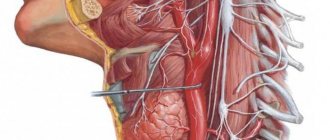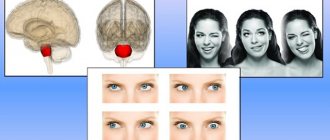Somatoform dysfunction of the autonomic nervous system is a disease accompanied by signs of dysfunction of internal organs.
However, numerous examinations reject the presence of organic pathology: the condition is due to a psychogenic nature. Often the concept is replaced by the terms vegetative-vascular dystonia or neurocirculatory dystonia, which are not included in the official international medical classification. ICD-10 classifies somatoform dysfunction as a neurotic disorder, defining it with code F 45.3.
Formation mechanism
The autonomic nervous system is the main regulator of the activity of internal organs, blood vessels and glands. Therefore, this system is often called visceral. The ANS regulates the functioning of organs in accordance with changes in environmental conditions.
The autonomic system is represented by two departments: sympathetic and parasympathetic, which have mutually opposite effects:
- The sympathetic nervous system mobilizes the body's defense reactions, preparing it for vigorous activity. Intensifies metabolism, increases arousal;
- The parasympathetic nervous system restores wasted energy. Stabilizes the body's condition. Supports its work during sleep.
Both departments have opposite effects on internal organs.
| Organ | Sympathetic NS | Parasympathetic NS |
| Heart | Tachycardia, increased force of contractions | Bradycardia, decreased force of contractions |
| Arteries | Constriction of organs, dilation of muscle vessels | Dilates blood vessels of the genitals and brain; narrows the coronary and pulmonary arteries. |
| Intestines | Inhibits peristalsis and enzyme synthesis | Enhances peristalsis and enzyme synthesis |
| Pulmonary system | Bronchial dilatation, hyperventilation of the lungs | Narrowing of the bronchi, decreased ventilation |
| Bladder | Relaxation | Reduction |
| Salivary glands | Depresses work | Stimulates saliva secretion |
| Pupil | Expands | Narrows |
The opposite influence of systems with balanced work helps to balance the condition of the internal organs. The ANS is not subject to human will. For example, we cannot make the heart stop beating. But vegetative activity is subject to the influence of stress factors. This is easy to check. Remember how your heart begins to “rumble” when you are scared. The mouth becomes dry, intestinal colic appears, and the urge to urinate increases. This activates the sympathetic department, mobilizing the body's protective resources.
The fear went away - the heart calmed down, breathing returned to normal. This is the merit of parasympathetics.
Problems begin when the activities of both departments are separated. There are several reasons for this imbalance:
- heredity;
- hormonal changes;
- chronic stress;
- powerful simultaneous stress impact;
- overwork;
- chronic intoxication;
- alcohol abuse;
- radiation;
- action of high temperatures.
Disharmony in the activity of the ANS triggers the formation of somatoform dysfunction of the autonomic nervous system. Vegetative control over organs decreases. Their work is disrupted, giving rise to painful symptoms, but there are no organic changes. The main reason is stress.
Somatic symptoms are a way of experiencing stressful situations at a physiological level. This was also discussed by Adler, who developed the concept of the symbolic language of organs. The theory said: organ systems specifically mirror mental processes.
General picture of the disorder
The main symptom of the disorder is the appearance of somatic symptoms affecting one or more organ systems.
The pathological manifestations are multiple, reminiscent of the clinical picture of a separate disease, but are characterized by blurriness, uncertainty, and rapid variability. A peculiarity of the presentation of complaints by patients is a special dramatism. Patients present symptoms emotionally vividly, exaggeratedly, using all kinds of epithets. They visit a huge number of doctors of various specialties and require examinations. When examinations refute the presence of physical pathology, the patient resists this news, is confident in the examination’s error and continues further vigorous diagnostic and treatment activities. Patients often spend years on “treatment” before a correct diagnosis is made.
Such people are quite sensitive to their own feelings, tend to exaggerate them, and often call an ambulance and are hospitalized. Numerous examinations and ineffective treatment fuel patients’ confidence in the presence of the disease. This situation causes distrust in individual specialists and medicine itself.
Prevention of the development of autonomic disorder
The patient can slow the progression of symptoms by taking care of his health by adhering to the following recommendations:
- Monitor your blood glucose levels regularly if you have diabetes;
- Avoid drinking alcohol and smoking;
- Follow your doctor's recommendations carefully if you have an autoimmune disease;
- Monitor your blood pressure levels;
- Exercise regularly;
- Eat a nutritious and balanced diet, watch your weight.
Somatic symptoms of dysfunction
The main target organs of somatoform dysfunction are the heart, lungs, and digestive tract.
Frequent complaints are heart pain that is not clearly localized. Cardialgia is attributed to a different character: stabbing, cutting, aching, squeezing, pressing, “scorching.” The intensity is variable: from unpleasant to painful, depriving sleep. The pain can persist for several minutes or hours and affects the area of the shoulder blade, arm, and right side of the chest.
The cause of pain is fatigue, anxiety, and weather changes. These appear after physical activity. This circumstance is important to take into account when differentiating VNS DM from angina pectoris, characterized by the appearance of pain during physical activity.
Cardialgia is accompanied by anxiety, restlessness, weakness, and lethargy. There is a feeling of lack of air, internal trembling, tachycardia, increased sweating.
You may feel a change in rhythm. Tachycardia is usually limited to 90-140 beats per minute, but is situational. It is provoked by changes in body position, drinking strong tea, coffee, alcoholic beverages or smoking. It goes away quickly. Often there is a feeling of fading, interruptions in the heart.
Pressure during somatoform dysfunction rises to reasonable limits, changes many times during the day, at night and stabilizes in the morning.
An indicative symptom of the respiratory system is shortness of breath, caused by a state of emotional stress. There is a pressing sensation in the chest. It's hard to take a breath. The patient experiences shortness of breath. Experiencing this, a person suffering from somatoform dysfunction constantly ventilates the premises and feels discomfort when being in closed spaces.
Patients are accompanied by frequent, shallow breathing, interrupted by periodic deep sighs. Attacks of neurotic cough occur.
Changes in the digestive system are characterized by:
- epigastric pain that occurs regardless of food intake;
- difficulty swallowing;
- stool disorder. The patient suffers from constipation or diarrhea;
- poor appetite;
- belching, heartburn, vomiting;
- improper salivation.
Somatoform dysfunction of the autonomic nervous system may be accompanied by hiccups, which are intrusive and quite loud.
VNS diabetes provokes urinary disorders. The urge becomes more frequent, and there is a need to empty the bladder in the absence of a toilet. Difficulty urinating in public toilets is typical.
Other signs of the disorder include low-grade fever, joint pain, fatigue, and decreased performance. Patients often suffer from insomnia, they become irritable and excitable.
It should be noted that the symptoms of somatoform dystonia are provoked by stress, nervous strain and are not caused by circumstances that cause the manifestations of an actual disease.
Somatoform dysfunction of the ANS has the following features:
- multiplicity of symptoms;
- non-standard nature of the symptoms shown;
- strong emotional reaction;
- discrepancy with the results of objective diagnostics;
- too intense severity of symptoms or, conversely, lack of brightness of symptoms;
- lack of response to standard provoking factors;
- futility of somatotropic therapy.
Pregnancy in women suffering from VSD
For women suffering from VSD, pregnancy raises many questions that cannot but worry them. Eg:
- Is pregnancy compatible with the disease?
- Are there any peculiarities of its course?
- Is there a chance that VSD will be inherited by the baby?
- Will pregnancy provoke an exacerbation of the disease due to hormonal changes?
- What to do with therapy with psychotropic drugs if they are prescribed: cancel or continue treatment.
To eliminate doubts it is necessary to dispel them.
The course of pregnancy with a diagnosis of VSD
Here we can say unequivocally - the course of pregnancy will not differ from the standard one. VSD does not in any way affect the pregnancy of the baby. Toxicosis and gestosis are likely, but this will not depend on the diagnosis of “vegetative-vascular dystonia”, but on the individual characteristics of the expectant mother and her general health indicators. It is worth saying that a woman, at the level of instincts, tries to protect her unborn baby, so the symptoms of VSD usually become less noticeable or disappear altogether.
If a woman has no contraindications to pregnancy, then VSD is not a reason to refuse the opportunity to become a happy mother.
Is VSD inherited?
VSD is not a hereditary disease. A child may have a predisposition to disturbances in the nervous system, but it is reliably known that the children of women suffering from vegetative-vascular dystonia, in 70 percent of cases, before reaching adulthood, never experienced a single symptom characteristic of VSD.
Of course, the baby, while in the womb, is exposed to all its conditions. Therefore, a pregnant woman needs to take maximum care, eat healthy foods, not take medications unless absolutely necessary, not experience stress, not be nervous, and lead a healthy lifestyle that excludes bad habits. It is necessary to carefully monitor compliance with all these conditions before reaching 13 weeks of pregnancy.
Any exposure to harmful factors can cause a malfunction in the baby’s central nervous system, which, in turn, can provoke VSD in the future.
Will the condition of a patient diagnosed with VSD worsen during pregnancy?
Usually, women diagnosed with vegetative-vascular dystonia feel better during pregnancy, childbirth and after it. The general condition improves, panic attacks practically disappear. This is a consequence of the fact that the body protects the baby by mobilizing the entire woman’s body. In addition, hormonal changes have a beneficial effect on the health of the expectant mother.
It is unlikely that you will be able to avoid headaches, attacks of heartburn, or increased blood pressure, but these signs are also typical for the pregnancy of healthy women, so this can hardly be considered a deviation from the norm.
The main thing is to immediately, at the very beginning, get rid of bad thoughts and tune in to the positive. You should try to let go of the situation and the body will cope on its own.
treatment of vegetative-vascular dystonia during pregnancy
It is better to avoid using antidepressants and psychotropic drugs while expecting a baby. But it is permissible to use them occasionally if there is a threat to the life of the expectant mother.
By using antidepressants during pregnancy, a woman threatens to provoke withdrawal syndrome in her baby after birth, which will definitely lead to depression of the central nervous system and increase the risk of developing defects and miscarriage.
As soon as you start planning a pregnancy, you should remember that during pregnancy and breastfeeding you will have to give up antidepressants, since their benefits for the mother cannot be compared with the harm that will be caused to the child. That is, bearing a child, childbirth and feeding presuppose a complete refusal to treat VSD.
Childbirth with VSD
Childbirth with a diagnosis of VSD takes place as usual, as in any healthy woman, if the general health of the woman in labor allows natural labor.
There's definitely nothing to be afraid of here. Author: K.M.N., Academician of the Russian Academy of Medical Sciences M.A. Bobyr
Associated mental disorders
Somatoform dysfunction is accompanied by other mental disorders.
The disease is often accompanied by phobic disorders . Characterized by fear of death, agoraphobia, cancerophobia, fear of blushing.
Panic attacks are an extremely common companion to the disorder. It is caused by a state of extreme fear and emotional stress. Characterized by an increase in the intensity of symptoms of the disease. It often provokes the development of depersonalization, fear of loss of consciousness, madness, and death.
Generalized anxiety disorder causes extreme tension, anxiety, and fears about the future. In addition to the characteristic manifestations of the disease, it contributes to the development of ideological and emotional phenomena. Worried about dizziness, weakness, feeling of lightheadedness. It is possible to develop derealization, when existing objects seem unreal, as well as depersonalization. The individual becomes hypersensitive, reacts sharply to extraneous stimuli, expecting danger.











